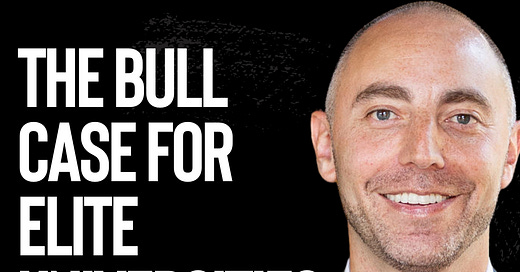What is the current state of college admissions? What social good do elite universities offer society, and how are they trying to do it better?
We discuss the state of elite universities with Matthew Rascoff, the Vice Provost for Digital Education at Stanford University.
Matthew is one of the most innovative administrators in the industry and a leader who puts ideas into action. He is pioneering new digital models to bring credit-bearing Stanford classes to lower-income high schools across the US.
With digital learning, Matthew is reaching upstream to build more effective bridges for young learners.
‘Insiders realize that the assessment system underpins the entire education system.’
Tune in this week to hear from a leader that will make you feel bullish on elite universities
We cover:
Matthew's journey from a horrible high school experience to a resurgence in college
The role of standardized testing in college admissions and prediction of performance
Admissions is one of the most creative areas of higher education today
The challenge of finding venture outcomes for “new measures of merit.”
Matthew’s venture to have Stanford offer credit-bearing courses to Title 1 high school students to increase access for low-income students.
The continuous challenge of professor-to-student ratio in higher education and the difficulty of scaling course quality
Please comment below.
We’d love to hear your thoughts, reactions, and questions.
Show Links:
Teaching at Harvard with an AI Faculty Co-Pilot by Jeff Bussgang
The Child is the Teacher: A Life of Maria Montessori
A Collection of Essays by George Orwell
Private universities have public obligations. Providing education to students from modest backgrounds isn’t a novelty at Stanford. It is part of who we are as an institution and dates back to our founding documents. By Matthew Rascoff
0 Comments














Share this post